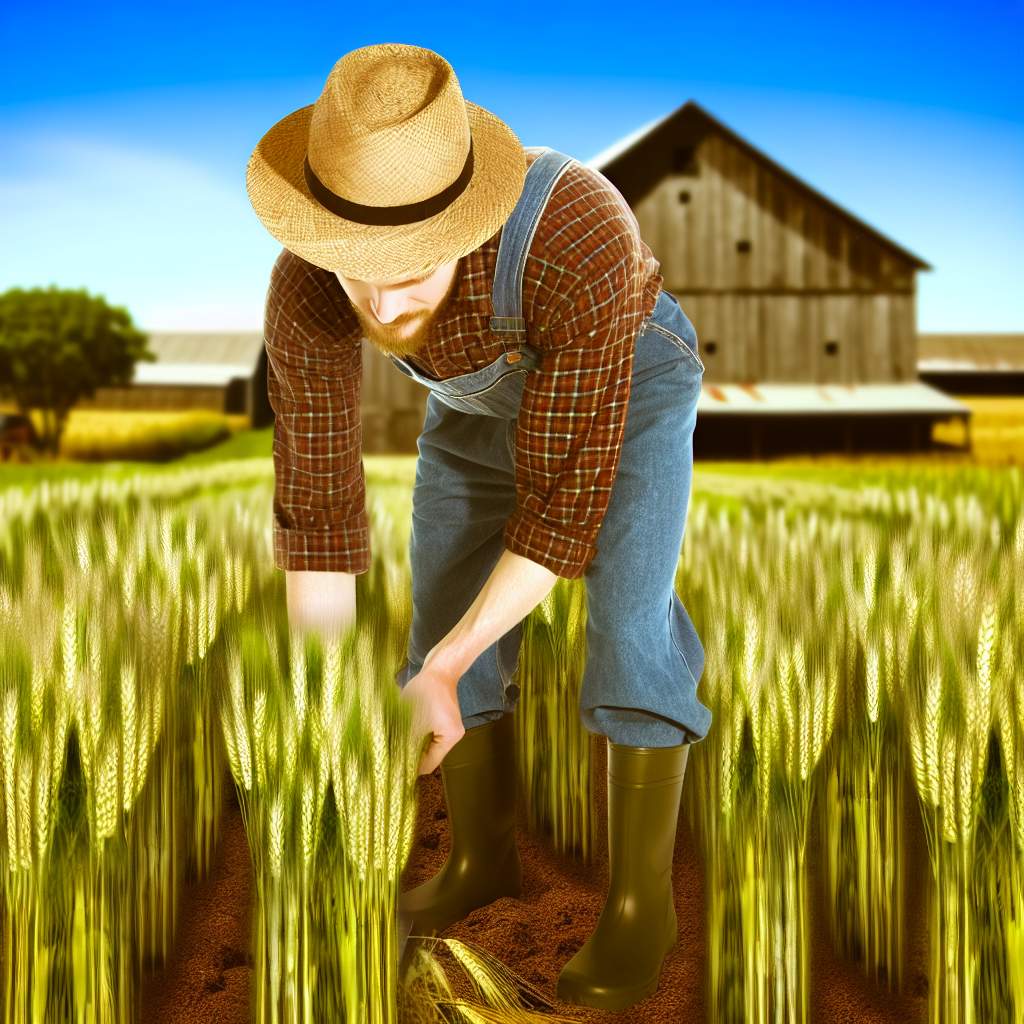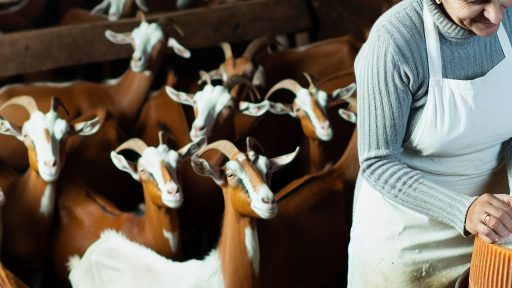Introduction to Heritage Grains and Their Importance
Defining Heritage Grains
Heritage grains refer to traditional varieties cultivated through sustainable methods.
These grains often exhibit unique flavors and nutritional profiles.
Farmers have grown heritage grains for centuries, passed down through generations.
Today, they serve as a vital component of agricultural biodiversity.
The Role of Heritage Grains in Biodiversity
Growing heritage grains supports the diversity of plant species in agriculture.
They offer distinct genetic variations crucial for food security.
Additionally, they help build resilience against climate change and pests.
Farmers frequently use heritage grains in crop rotation systems.
Preserving Cultural Heritage
Heritage grains connect us to our agricultural history and traditions.
These grains often carry stories and cultural significance for communities.
Farmers like Maeve Collins celebrate their heritage by growing these varieties.
They host events that educate others about the importance of maintaining these grains.
The Economic Benefits of Heritage Grains
Heritage grains can provide farmers with niche markets for their products.
These markets often yield higher prices compared to conventional grains.
By offering unique flavors, heritage grains attract consumers seeking authenticity.
Transform Your Agribusiness
Unlock your farm's potential with expert advice tailored to your needs. Get actionable steps that drive real results.
Get StartedRestaurants and local shops often prioritize sourcing heritage grains.
The Environmental Impact of Heritage Grain Farming
Growing heritage grains promotes sustainable agricultural practices.
Farmers often use organic methods to cultivate these grains, reducing chemical usage.
Moreover, heritage grains can adapt to local climates, minimizing resource needs.
This approach leads to healthier soil and ecosystems.
Understanding Agricultural Biodiversity and Its Benefits
Defining Agricultural Biodiversity
Agricultural biodiversity refers to the variety of life that exists in agricultural systems.
This includes plants, animals, and microorganisms used for food, fiber, and other benefits.
Moreover, it encompasses the genetic diversity within these species.
This diversity is crucial for food security and ecosystem health.
Importance of Agricultural Biodiversity
Agricultural biodiversity provides numerous benefits to ecosystems and human societies.
Firstly, it enhances the resilience of agricultural systems.
Resilience ensures crops can withstand pests, diseases, and climate changes.
Secondly, it supports ecosystem services like pollination and soil fertility.
These services are vital for sustaining agricultural production.
Impact on Food Security
Diverse crops and livestock improve food security by offering varied food sources.
This diversity helps mitigate risks associated with crop failure.
Additionally, it enables farmers to adapt to changing market demands.
Consequently, communities benefit from a stable food supply.
Conservation of Heritage Grains
Heritage grains play a significant role in preserving agricultural biodiversity.
These grains often possess unique traits that enhance resilience.
They can thrive in specific local environments, maintaining genetic diversity.
Many heritage varieties also offer valuable nutritional qualities.
Safeguarding Our Future Food Systems
Understanding agricultural biodiversity is essential for sustainable farming practices.
By promoting diverse crops and livestock, we safeguard our future food systems.
Showcase Your Farming Business
Publish your professional farming services profile on our blog for a one-time fee of $200 and reach a dedicated audience of farmers and agribusiness owners.
Publish Your ProfileFurthermore, we enhance the overall health of our ecosystems.
Through efforts like growing heritage grains, we can preserve this invaluable diversity.
Historical Background of Heritage Grains
The Origins of Heritage Grains
Heritage grains have roots that trace back thousands of years.
Farmers cultivated these grains for their resilience and adaptability.
These varieties played crucial roles in traditional diets around the world.
As agriculture modernized, many heritage grains fell out of favor.
However, a renewed interest has sparked their resurgence in recent years.
Characteristics of Heritage Grains
Heritage grains are often open-pollinated, unlike hybrids.
This characteristic allows farmers to save seeds for future planting.
Many of these grains have unique flavors and nutritional profiles.
They also typically require fewer chemical inputs than modern varieties.
Consequently, they contribute to both health and sustainability.
Popular Varieties of Heritage Grains
Some well-known heritage grain varieties include spelt and einkorn.
These grains excel in adaptability to diverse growing conditions.
Other notable varieties are durum wheat and red fife.
Each of these grains carries historical significance and varied flavors.
They often thrive in organic and sustainable farming systems.
Traditional Cultivation Practices
Farmers historically relied on traditional methods for cultivating these grains.
Crop rotation and mixed cropping were common practices.
These methods naturally supported soil health and resilience.
Today, many farmers are adopting these practices once again.
Such practices enhance biodiversity and restore ecological balance.
Uncover the Details: The Connection Between Organic Farming and Food Transparency
Current Challenges Facing Heritage Grains in Modern Agriculture
Declining Popularity
Heritage grains are losing popularity among modern farmers.
Many prefer high-yield varieties for economic reasons.
This preference threatens genetic diversity in agriculture.
As a result, traditional grains are being abandoned.
Climate Change Impacts
Climate change poses significant risks to agriculture.
Shifts in temperature and precipitation affect crop yields.
Heritage grains may struggle to adapt to these changes.
Moreover, pests and diseases may become more prevalent.
Market Accessibility
Accessing markets remains a challenge for heritage grains.
Many consumers are unaware of these grains’ benefits.
Additionally, heritage grains often have limited distribution.
This results in lower demand and financial viability.
Knowledge and Education Gaps
Farmers often lack knowledge about growing heritage grains.
Modern agricultural education focuses on conventional practices.
Without proper training, farmers may hesitate to switch crops.
Consequently, traditional growing methods risk being forgotten.
Regulatory Barriers
Regulations pose additional challenges for heritage grain producers.
Showcase Your Farming Business
Publish your professional farming services profile on our blog for a one-time fee of $200 and reach a dedicated audience of farmers and agribusiness owners.
Publish Your ProfileCertification processes can be complex and cumbersome.
These barriers hinder small-scale farmers from entering markets.
Moreover, regulatory support for heritage grains is often lacking.
Uncover the Details: Crop Rotation Strategies That Foster Biodiversity In American Agriculture
Techniques for Cultivating Heritage Grains: Soil Health and Sustainable Practices
Importance of Soil Health
Soil health is fundamental to growing heritage grains.
Healthy soil enhances nutrient availability and water retention.
This, in turn, supports robust crop growth and yields.
Practices to Improve Soil Health
Implementing cover crops is an effective technique.
These plants protect the soil and prevent erosion.
They also enhance organic matter levels in the soil.
Crop rotation diversifies soil nutrients and disrupts pest cycles.
Farmers can use legumes to naturally fix nitrogen in the soil.
Sustainable Farming Techniques
Sustainable practices minimize environmental impact.
One approach is to reduce chemical inputs.
Using organic fertilizers promotes healthier soils.
Additionally, practicing conservation tillage preserves soil structure.
Water Management Strategies
Proper water management ensures optimal growing conditions.
Irrigation techniques must align with local climate conditions.
Utilizing rainwater harvesting systems can be advantageous.
Farmers should monitor soil moisture closely to avoid overwatering.
Emphasizing Biodiversity
Planting a variety of heritage grains enhances biodiversity.
This diversity can improve pest resistance and crop resilience.
Farmers should also consider intercropping different species.
Such practices promote a balanced ecosystem on the farm.
Community Engagement and Education
Educating the community about heritage grains is essential.
Workshops and farm visits can increase awareness and interest.
Collaborative projects can support local grain economies.
Farmers can partner with schools to teach about sustainable practices.
Explore Further: How Traceability Systems Help Farmers Meet Food Safety Standards
Economic Benefits of Growing Heritage Grains for Farmers
Diverse Market Opportunities
Growing heritage grains opens new market avenues for farmers.
Market demand for unique and ancient grain varieties has surged.
Consumers increasingly seek out heritage grains for their distinct flavors.
Farmers can capitalize on niche markets, maximizing profits.
Restaurants and artisanal bakeries often prefer these grains for premium products.
Higher Profit Margins
Heritage grains typically fetch higher prices than conventional varieties.
Consumers are willing to pay a premium for organic and heirloom products.
This translates into better financial returns for farmers.
By selling directly to consumers, farmers can further increase their margins.
Increased Resilience and Reduced Risk
Heritage grains often exhibit greater resilience to pests and diseases.
This reduces the need for chemical interventions, saving costs.
Showcase Your Farming Business
Publish your professional farming services profile on our blog for a one-time fee of $200 and reach a dedicated audience of farmers and agribusiness owners.
Publish Your ProfileDiversity within crops contributes to better overall farm health.
Farmers benefit from lower investments in pest control and fertilizers.
Environmental Benefits and Sustainability
Heritage grains require less water and inputs than conventional crops.
This encourages sustainable farming practices in agricultural communities.
Farmers contribute to soil health by rotating diverse crops.
Environmental sustainability enhances long-term productivity and viability.
Community Engagement and Local Economy
Growing heritage grains fosters connections within local communities.
Farmers can participate in farmers’ markets, enhancing visibility.
This involvement helps strengthen the local economy.
Heritage grains often create local partnerships with food artisans.
Education and Awareness
Educating consumers about heritage grains boosts awareness.
Workshops and tours can attract visitors to local farms.
This creates an opportunity to share knowledge and techniques.
Farmers become ambassadors for biodiversity and sustainability.
Delve into the Subject: Food Waste Reduction Guidelines for Farm-to-Market Producers

Promoting Consumer Awareness: The Role of Farmers' Markets and Local Food Systems
Understanding Farmers' Markets
Farmers' markets serve as vital community hubs for local food distribution.
They provide direct access to fresh produce and heritage grains.
Moreover, these markets foster relationships between consumers and farmers.
Many people come to appreciate the importance of supporting local agriculture.
The Impact of Local Food Systems
Local food systems contribute significantly to agricultural biodiversity.
By promoting heritage grains, these systems preserve unique plant varieties.
Consumers who choose local products often support sustainable farming practices.
This, in turn, encourages the continuation of diverse farming methods.
Educating Consumers
Education is key to raising awareness about heritage grains.
Farmers' markets often host workshops and tastings to engage the public.
Events like cooking demonstrations highlight the benefits of using traditional cereals.
Additionally, informational signage helps shoppers understand the value of biodiversity.
Building Community Connections
Farmers' markets strengthen community ties through shared experiences.
Local food systems encourage collaboration among farmers and artisans.
Such initiatives promote a sense of belonging and mutual support.
They also generate interest in preserving local agricultural heritage.
Encouraging Sustainable Choices
When consumers support farmers' markets, they make sustainable choices.
They contribute to reducing food miles by purchasing locally.
This practice helps to minimize carbon footprints and environmental impacts.
Consequently, awareness of agricultural biodiversity increases among consumers.
Highlighting the Benefits of Heritage Grains
Heritage grains offer diverse flavors and nutritional profiles.
Educating consumers about these benefits enhances their appreciation.
Ultimately, this knowledge can lead to increased demand and cultivation.
Farmers' markets play a crucial role in this educational effort.
Case Studies: Successful Heritage Grain Farms and Their Impact
Innovative Practices at Green Fields Farm
Green Fields Farm is pioneering heritage grain cultivation in Vermont.
Showcase Your Farming Business
Publish your professional farming services profile on our blog for a one-time fee of $200 and reach a dedicated audience of farmers and agribusiness owners.
Publish Your ProfileThis farm grows ancient grains like einkorn and emmer wheat.
These varieties provide unique flavors and nutrition profiles.
Furthermore, they adapt well to local climatic conditions.
Farmers practice rotational grazing alongside grain planting.
This method improves soil health and promotes biodiversity.
As a result, Green Fields Farm showcases sustainable farming techniques.
Community Engagement at Prairie Roots Farm
Prairie Roots Farm in Kansas engages the local community.
The farm hosts educational workshops on heritage grains.
Through these workshops, attendees learn about grain diversity.
Additionally, they explore baking techniques using ancient grains.
This initiative strengthens local food systems and connections.
Moreover, Prairie Roots offers grains at local farmers’ markets.
This allows consumers to access nutritious, locally-sourced food.
Research Development at Heritage Grains Center
The Heritage Grains Center in Oregon focuses on research and development.
The center collaborates with farmers on grain trials.
They evaluate the performance of various heritage varieties.
This research aims to enhance crop resilience and yield.
Furthermore, it helps identify grains suited for different environments.
The center also publishes findings for public awareness.
Consequently, they influence farming practices regionally and nationally.
Successes and Impact on Agricultural Biodiversity
These case studies highlight the impact of heritage grain farming.
Successful farms promote biodiversity and sustainable practices.
They provide consumers with unique options while preserving varieties.
Moreover, these initiatives strengthen local economies and communities.
Ultimately, they contribute to a more resilient food system.
Through collaboration, education, and research, heritage grains thrive.
Policy Recommendations to Support Heritage Grain Cultivation
Encouraging Research and Development
Investing in research for heritage grains fosters innovation.
This research should focus on yield improvement and pest resistance.
Additionally, collaboration with universities can yield valuable insights.
Grant programs can support these research initiatives effectively.
Supporting Farmers with Financial Incentives
Farmers require financial support to grow heritage grains.
Implementing subsidies can lower the cost of seeds and equipment.
Offering tax incentives encourages farmers to diversify their crops.
Moreover, providing low-interest loans can assist in farm improvements.
Promoting Awareness and Education
Awareness campaigns can educate the public about heritage grains.
Schools and community programs should include agriculture education.
Workshops can enable farmers to share knowledge and experiences.
Additionally, partnering with local chefs can highlight unique recipes.
Enhancing Market Access
Expanding market access is crucial for heritage grain farmers.
Establishing farmers’ markets allows direct sales to consumers.
Showcase Your Farming Business
Publish your professional farming services profile on our blog for a one-time fee of $200 and reach a dedicated audience of farmers and agribusiness owners.
Publish Your ProfileCollaboration with local grocery stores can feature heritage grains.
Online platforms also provide opportunities for wider distribution.
Advocating for Regulatory Support
Regulatory frameworks should support heritage grain cultivation.
Policies must prioritize biodiversity and sustainable practices.
Streamlining certification processes can benefit small-scale farmers.
Furthermore, advocating for land preservation policies is essential.
Future Prospects: Integrating Heritage Grains in Climate-Smart Agriculture
Overview of Climate-Smart Agriculture
Climate-smart agriculture (CSA) focuses on sustainable farming practices.
It aims to improve resilience amidst climate change.
This approach enhances productivity and ensures food security.
Heritage grains can play a significant role in CSA.
Benefits of Heritage Grains in CSA
Heritage grains are more resilient to extreme weather conditions.
They require fewer chemical inputs compared to modern varieties.
These grains support biodiversity, enriching agricultural ecosystems.
Moreover, they can be crucial in maintaining soil health.
Integrating Heritage Grains into Farming Practices
Farmers can adopt crop rotations that include heritage grains.
This practice diversifies production systems, reducing risks.
Additionally, intercropping with heritage grains can boost yields.
Farmers should also utilize organic practices to enhance soil health.
Challenges and Solutions
Adoption of heritage grains faces several challenges.
A lack of awareness among farmers remains a significant barrier.
To overcome this, educational programs must be implemented.
Furthermore, access to heritage seeds needs improvement.
Collaborations with local organizations can facilitate seed sharing.
Future Research Directions
Research should focus on breeding new heritage varieties.
These varieties should be specifically adapted to local climates.
Moreover, studies on the nutritional benefits of heritage grains are vital.
Funding for research in heritage grains needs to increase.
Engaging Communities for Adoption
Community involvement can enhance the adoption of heritage grains.
Workshops and farming festivals can create awareness.
Local chefs can promote heritage grains through culinary innovations.
Engaging youth in agriculture can secure the future of heritage grains.
Additional Resources
Seed laws that criminalise farmers: resistance and fightback – GRAIN
For Thousands of Years, Indigenous Tribes Have Been Planting for …




